GASnews


SPRING 2024 VOLUME 38 ISSUE 1


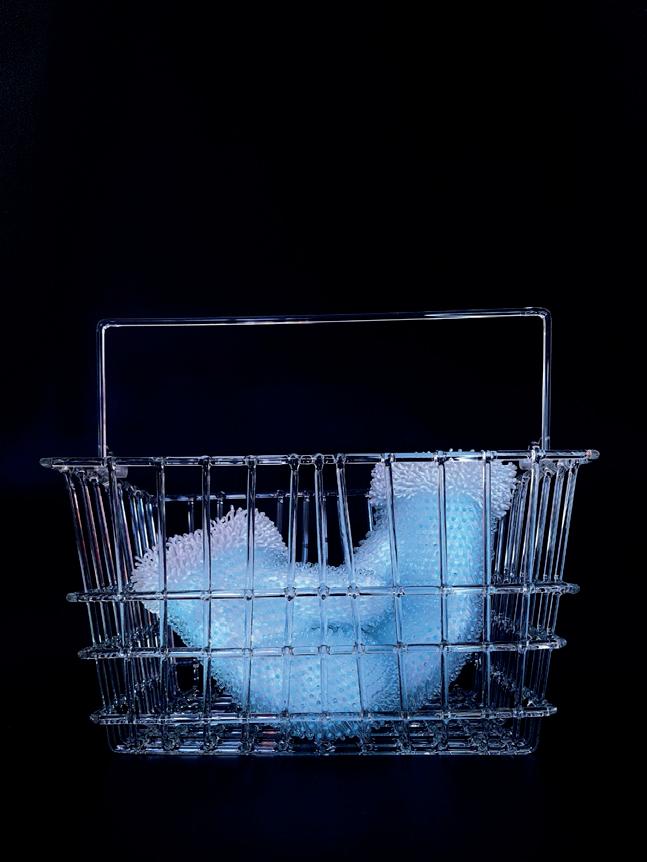


Contributing Writers: Jennifer Hand, Amanda Crans, Maria E. Diaz de Vivar, John Erwin Dillard, Kehinde Adepetun and Danielle Hayden
Editor : Robin Babb
Graphic Design: Marja Huhta
Staff
Brandi P. Clark, Executive Director
Amanda Crans, Communications Manager
Jennifer Hand, Conference + Events Manager
Marja Huhta, Digital + Design Assistant
Julie Thompson, Development Manager
KCJ Szwedzinski, Operations Assistant
Robin Babb, GASnews Editor
Cathy Noble-Jackson, Part-time Bookkeeper

Glass Ar t Societ y
Board of Directors 2023-2024
President: Michael Saroka
Vice President: Nadania Idriss
Treasurer: John Moran
Secretary: Lisa Zerkowitz
IDEA Chair: Kim Thomas
Conference Chair: Eric Goldschmidt
Ben Cobb
Mika Drozdowska
Percy Echols II
Frederik Rombach
Debra Ruzinsky
Sunny Wang
Martha Zackin
Leia Guo (North
Jocelyn
INSIDE
Student Representative)
American
Chan
Representative) GAS news 700 NW 42nd Street #101, Seattle, WA 98107 USA Phone: 206 382 1305 E- mail: info @ glassar t.org Web: www.glassar t.org © 2024 The Glass Art Society, a non-profit organization. All rights reserved. Publication of articles in this newsletter prohibited without permission from the Glass Art Society Inc. The Glass Art Society reserves the right to deny applications for GAS Market, advertising participation, GAS membership or conference participation to anyone for any reason. 3 Letters from the Editor and Executive Director 4 See You in Berlin! Conference Preview 6 Sini Majuri: Creating Possibilities at the Intersections 10 Glass Design and Craftsmanship: A Creative Dialogue with Ferran Collado 13 Diseño y Artesanía en Vidrio: Un Diálogo Creativo con Ferran Collado 16 Earth Ængel, Fluid Futurity in Art and Design 19 Glass Fashion Takes Centre Stage 22 A Two-Way Mirror: Exhibition Reflects Racial Realities 26 Member Spotlight: Ivan Lambrov 29 GAS Opportunities Cover: Sini Majuri, Antimatter Exhibtion 1. Photo courtesy of the artist. GA S NEWS SPRING 2024 VOLUME 38, ISSUE 1 2 new: also available as ePaper subscribe easily online: www.neuesglas-newglass.com info@neuesglas-newglass.com 4 issues a year GERMAN/ENGLISH NEW GRADUATE REVIEW 2023 +
(International Student

EDITOR’S LETTER
Dear GASnews readers,
As we’ve been gearing up for our conference in Berlin this May, which takes the theme “Where Art + Design Meet,” we’ve been thinking about the real-world examples of collaboration between artists and designers. This issue of GASnews features some of those examples—the groundbreaking works of Sini Majuri and Chelsea Rousso, who are both delving into the liminal world of glass fashion; the genre-bending Dolphin Gurlz series from artist Earth Ængel; as well as a look at the emerging artists and emerging consciousness in A Two-Way Mirror: Double Consciousness in Contemporary Glass by Black Artists at The Museum of Glass.
In that same spirit of collaboration and crossing genres, this issue has writing not only from those steeped in the world of glass art, but also from the arts writers Kehinde Grace Adepetun and Danielle Hayden. Both bring a fresh perspective to these pages, with excellent reporting and clever writing.
I hope you enjoy reading these stories, and that they encourage you to bring collaboration and crossovers into your own art practices and lives.
 Robin Babb GASnews Editor
Robin Babb GASnews Editor

DIRECTOR’S LETTER
Dear GASnews readers,
The next couple of months will bring GAS to two exciting glass destinations - Japan in April for our inaugural Travel Program trip and Germany in May for the 2024 GAS Conference in Berlin. We are excited to push the boundaries of what “art” and “design” mean and also to expand our efforts to make GAS a truly global organization.
2024 is going to be a pivotal year for GAS as we explore new initiatives that will provide platforms for sustainable glassmaking, emerging voices, and more. Learn more about these transformational initiatives on our website.
In this issue of GASnews, our writers explore the intersection of art and design in glass. Amanda Crans writes about Sini Majuri and Marja Hepo-aho’s groundbreaking fashion collection that brought glass to new audiences this year at New York Fashion Week; John Erwin Dillard examines the design sensibility in Earth Ængel’s new artworks; and Maria E. Diaz de Vivar engages in a thoughtful conversation with the Barcelona-based artist Ferran Collado about his collaborations with designers.
Happy reading, and we cannot wait to see you in Berlin!
 Brandi P. Clark Executive Director
Brandi P. Clark Executive Director
GA S NEWS SPRING 2024 VOLUME 38, ISSUE 1 3
SEE YOU IN BERLIN! GET READY FOR “WHERE ART + DESIGN MEET,” MAY 15–18
by Jennifer Hand
Berlin is a city synonymous with culture, from its legendary nightlife to the staggering number of museums scattered throughout its landscape. On any given day, a visitor to Berlin can view a Vermeer at the Gemäldegalerie, sip a cold craft beer while enjoying live music at one of the city’s many riverside beer gardens, explore stacks of signage at the eclectic BUCHSTABENMUSEUM, or wander the length of the East Side Gallery to take in contemporary murals painted on what remains of the Berlin Wall. This year, attendees of the 2024 Glass Art Society conference will be able to enjoy these cultural delights while also seeing a different side of the city.
On a typical Berlin afternoon near the entrance of Berlin Glas, a calico cat named Punty stalks across the courtyard, completely unperturbed by the roar of the fluffy torch behind him. The Berlin Glas studio team is busy at work bringing the fabrication dreams of a local designer to reality at Berlin’s first open-access hot shop, operating for more than twenty years under its leader and the Berlin Site Committee Chair, Nadania Idriss. Berlin Glas is only one of several cultural outlets in its vicinity. The neighboring creative campus known as Monopol is home to artist incubators, studios, galleries, and maker spaces, and recently welcomed Bard College Berlin to build its new campus on its grounds. Several spaces among Berlin Glas, Monopol, and Bard will comprise the 2024 conference’s Provinzstraße Hub, so named after the local cross street, accessible via Berlin’s plentiful public transport at the Schönholz station. From Thursday, May 16th to Saturday, May 18th, highlights of the program there will include hot glass demonstrations by Ned Cantrell, Jahday Ford, Simone Fezer, and a special guest from Netflix’s Blown Away, as well as performances by RIT Glass students led by Suzanne Peck, lecturedemos by Saman Kalantari and Anthony Amoako Attah, and a Friday “Flame Off” party inviting flameworkers from around the world to collaborate into the evening hours. The Berlin Glas team will use its years of experience offering youth programming to provide a “Kids Oasis” for

ArtworkbyAnthonyAmoakoAttah

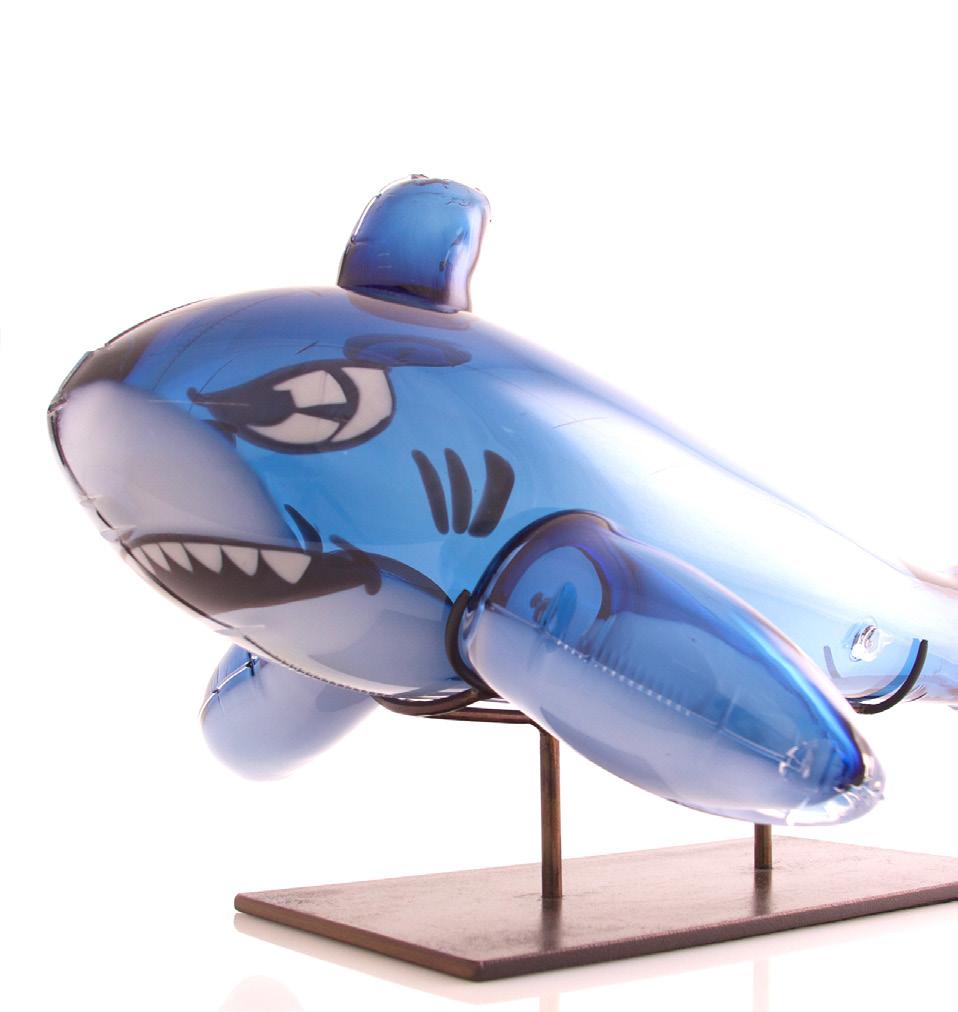

GASNEWS SPRING 2024 VOLUME 38, ISSUE 1 4
ArtworkbySilviaLevenson
ArtworkbyNedCantrell ArtworkbySamanKalantari
youth attending the conference—a first-ofits-kind opportunity—and mobile furnaces provided by Niesenglass will be on site to demonstrate that glassy power can come in surprisingly small packages.
Less than a five-minute train ride from the action at Provinzstraße, conference attendees can enjoy the array of offerings at the central hub, Wilhelm Hallen’s Hall C. Wilhelm Hallen is a former iron foundry which now serves as an event center and creative campus. Inside Hall C, along with longstanding GAS standards like the annual exhibitions and this year’s GAS Market, visitors can find the main stage activated with daily themed interactive programming, enjoy lectures and panels, take a rest at the GAS Lounge and Charging Station, and find refreshment and entertainment just outside at the Beer Garden and Green Pavilion.
Cold working will dominate the program this year, with incredible demonstrations by the international coldworking collective The Lathe Riders serving as the centerpiece of the conference kickoff and continuing to impress throughout the week’s festivities. The main stage will feature a keynote lecture from Silvia Levenson first thing Thursday morning, and a Friday morning
lecture from the Corning Museum of Glass' head buyer, Meghan Bunnell, will draw makers eager for tips on how to get their wares noticed by wholesalers.
With an all-new Film Festival and the exciting addition of a jewelry trunk show on Thursday night, every evening of this year’s conference will be full of opportunities to connect, shop, and get inspired by the kaleidoscope of ways glass manifests itself in our community. Just add a currywurst snack and a museum (or a dozen) to the itinerary, and the quintessential Berlin experience is complete—all that’s missing is you!
Jennifer Hand is the Conference + Events Manager at GAS.
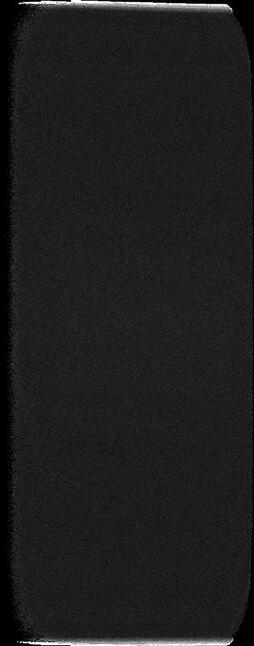
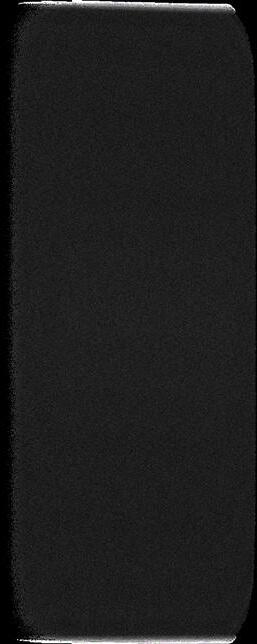


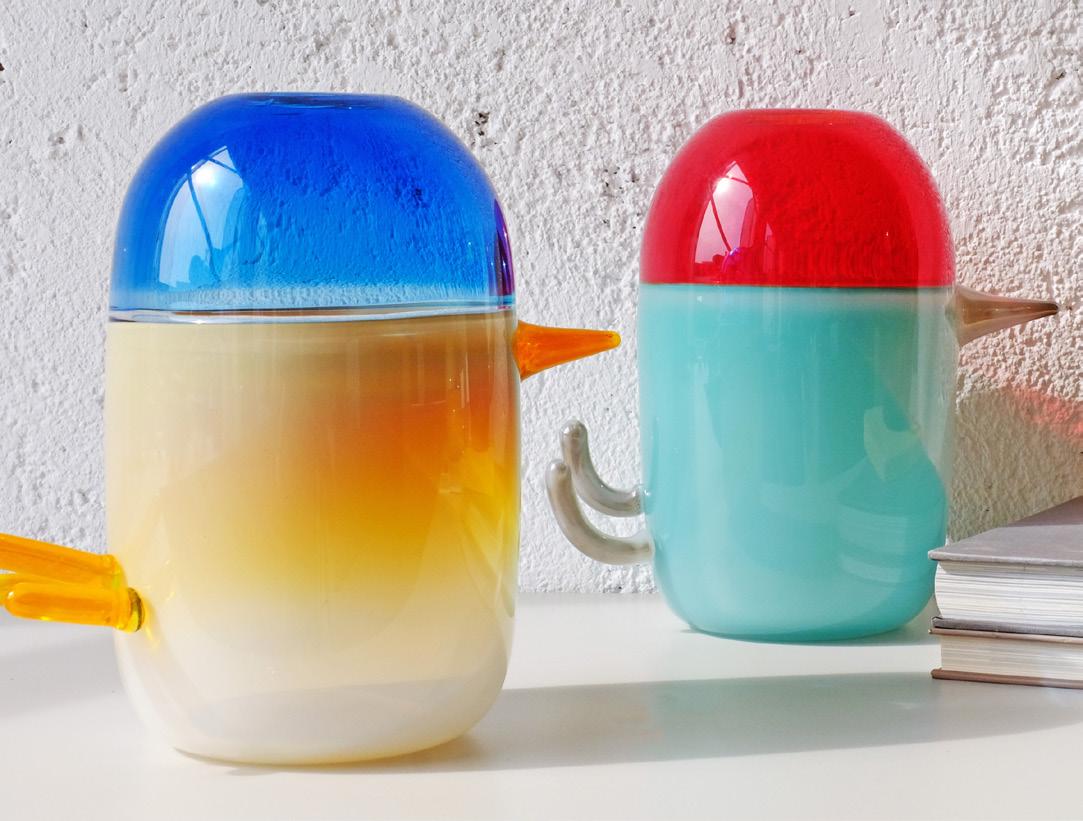


GA S NEWS SPRING 2024 VOLUME 38, ISSUE 1 Annual GAS Conference Registration open now at glassart.org! Berlin, Germany | May 15 - 18
ArtworkbyMertUngor
ArtworkbyKarenNyholm
ADVERTISE with us! www glassart org/advertise-with-us
SINI MAJURI: CREATING POSSIBILITIES AT THE INTERSECTIONS
by Amanda Crans
It’s been a great start to the year for Finnish artist and designer Sini Majuri. Her work was recently featured in The New York Times, which was a lifelong dream come true as she read the NYT growing up to learn English. Just in February, Infinity Vessel, a project she created with longtime collaborator Marja Hepo-aho, made a splash as part of New York Fashion Week and the collaborators participated in a panel at the Finnish Embassy about the future of glass art. At the panel, Majuri said, “We are very excited about this opportunity; we have the chance to make a statement about glass as an artistic medium, reach new audiences, and bring women’s rights to the forefront. The Infinity Vessel catwalk show was very personal to us designers. Through it, we wanted to reflect on the archetypes of femininity and engage in a discussion about how women are perceived in society. The archetypesMadonna, whore, victim, forbidden woman, mother, old woman, evil, and matriarch


- each represent both the societal woman and our shared experience and relationship with femininity. Particularly, women's rights and the right to their own bodies are at the forefront of the work. Glass embodies humanity in the artworks.”
Majuri certainly has an unprecedented opportunity to bring glass to the world—the show is annually covered by publications like Vogue and E!, bringing roughly 16 million eyes to Hepo-aho and Majuri’s designs. Majuri’s participation in the Flying Solo show, which showcases newcomers to the fashion industry, blends together two of her greatest passions: fashion and glass. Majuri’s design sensibilities shine in both her glass and fashion work; the fluidity of fabrics used in the fashion show mimic the fluid lines present in her glass production. For Infinity Vessel, they also collaborated with shoemakers and fashion designers
to create impossibly tall glass high heels and other sparkling vetements—bringing together seemingly disparate media to highlight the beauty of the handmade.

GASNEWS SPRING 2024 VOLUME 38, ISSUE 1 6
Infinity Vessel at Flying Solo at New York Fashion Week. Photo by AC_Photography_Chicago.
Infinity Vessel at New York Fashion Week. Photo courtesy of Sini Majuri.
Tony Jewelry. Photo courtesy of Sini Majuri.

Much of Majuri’s work operates along this theme: highlighting duality and tension to make a statement. Glass is her favorite medium because of all the tensions inherent in it. “I’ve been working in glass for ten years and I know I’ll never know everything about it; glass never reveals everything,” said Majuri. “Glass is the key technology that has enabled humanity to discover the universe, from the galaxies to the microscopic; it’s even the backbone of the Internet.”
The traditional means of producing glass, new technologies like 3-D printing or AI; fragility and strength; revealing and obscuring; transparency and distortion—these contradictions are all exquisitely explored in Majuri’s work. In her view, “no other material can reflect the interior emotions of a person like glass.”
The Infinity Vessel project includes a piece that is truly emblematic of the way Majuri
works and sees the world. A delicate-looking glass vessel, representing the womb, is decorated with gold enamel that enhances its apparent fragility. Made of colorless glass, the vessel allows the viewer to see a cast bronze fetus clinging to life inside the form. Looking closer, the gold enameled serpents at the head of the vessel reflect Finnish traditions—they symbolize protection. Majuri’s work blends together beauty and social activism; in many bodies of her work, she lures the viewer in with the irresistible sheen of glass and has the viewer consider some of the most pressing social issues of our time. In Infinity Vessel, Majuri and Hepo-aho address women’s rights and how women in abusive relationships are often separated from their communities and kept isolated. “The meaning of art is to provide safe spaces to talk about difficult things,” says Majuri.

GA S NEWS SPRING 2024 VOLUME 38, ISSUE 1 7
This ability to balance beautiful form with Sini Majuri, Mirrored. Photo courtesy of the artist.
Sini Majuri, Antimatter Exhibtion 1. Photo courtesy of the artist.
a strong message also emerges in Majuri’s design lines. Referencing the snowy environs that used to be emblematic of Scandinavia, Majuri creates objects for the home that freeze a glacier in time, placing the enormity of the climate crisis into the home where someone can not only enjoy the beauty of the glass, but also consider the rapidly deteriorating environment.
Majuri isn’t afraid to be experimental and use a mixture of the traditional and the new to create exciting possibilities in her work, too. Late last year, UNESCO
designated “knowledge, craft, skills of handmade glass productions” as intangible cultural heritage, an initiative that was spearheaded by Finnish glassmakers. Majuri finds this designation incredibly important. “It recognizes the rare knowledge glassmakers have and gives us an opportunity to preserve the traditions while discovering new ways of working and adding oxygen to the field.” She has taken the traditional Scandinavian technique of the graal (a blown glass piece, typically with several color layers, that is sandblasted to create a pattern on the
surface) and added a contemporary touch to it with silk screen-printed decals that she adds to her pieces in between layers of glass. The silkscreen harkens back to her love of traditional craft and she purposely designs images that look fragile and old.
“When you view these images through the glass, it’s like you’re seeing something ancient preserved forever in a time capsule, never aging—a paradox.”
One of her newest works, ROBOBALLET, is a performance depicting the battle between humans and machines that includes a

GASNEWS SPRING 2024 VOLUME 38, ISSUE 1 8
Sini Majuri, Wall Pieces. Photo by: Juhamatti Vahdersalo.
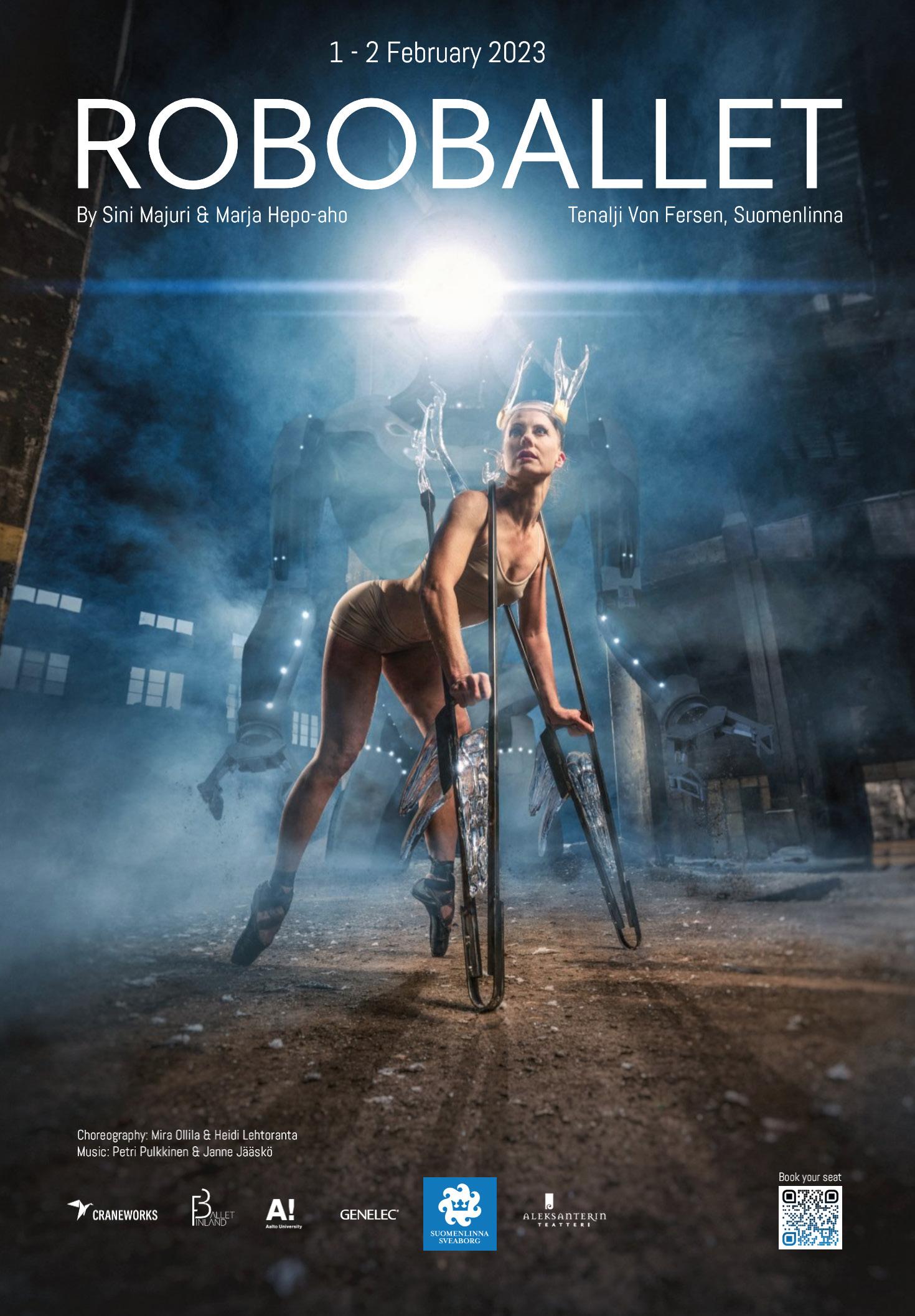
robot designed for military operations dancing with a ballerina. For this project, she collaborated with a ballerina who choreographed the routine while Majuri produced the glass pieces that adorned the dancers. Another current fascination of Majuri’s is AI; she’s using Midjourney to generate images of beautiful people. AI is only as intelligent as the humans and algorithms that feed it, and she’s using the images of stereotypically beautiful people that AI produces as a mirror for our
societal expectations. Instead of using AI to transplant the role of the artist, Majuri is using those generated images in 3-D graal vessels to distort the distortion of societal expectations, blending the machine and the handmade, the traditional and the new.
Often seen as two separate disciplines, the intersection of art and design features heavily in Majuri’s work. She’s been awarded the Golden A’ Design Award and has served on the Grand Jury for that
award twice. “When presented with these opportunities, I use them to advocate for glass as an artistic and design material. International design competitions need to see more contemporary glass—this cultural exchange brings more fuel and potential to both fields,” explains Majuri. As such a hand-crafted material, glass presents her with the opportunity to create a link between herself and the viewer or the consumer, and she wants to see more designers embrace handmade glass. “The moment you use a handmade item, you’re participating in this peaceful ceremony between you and the maker. You don’t get that same experience with factory-made glass.”
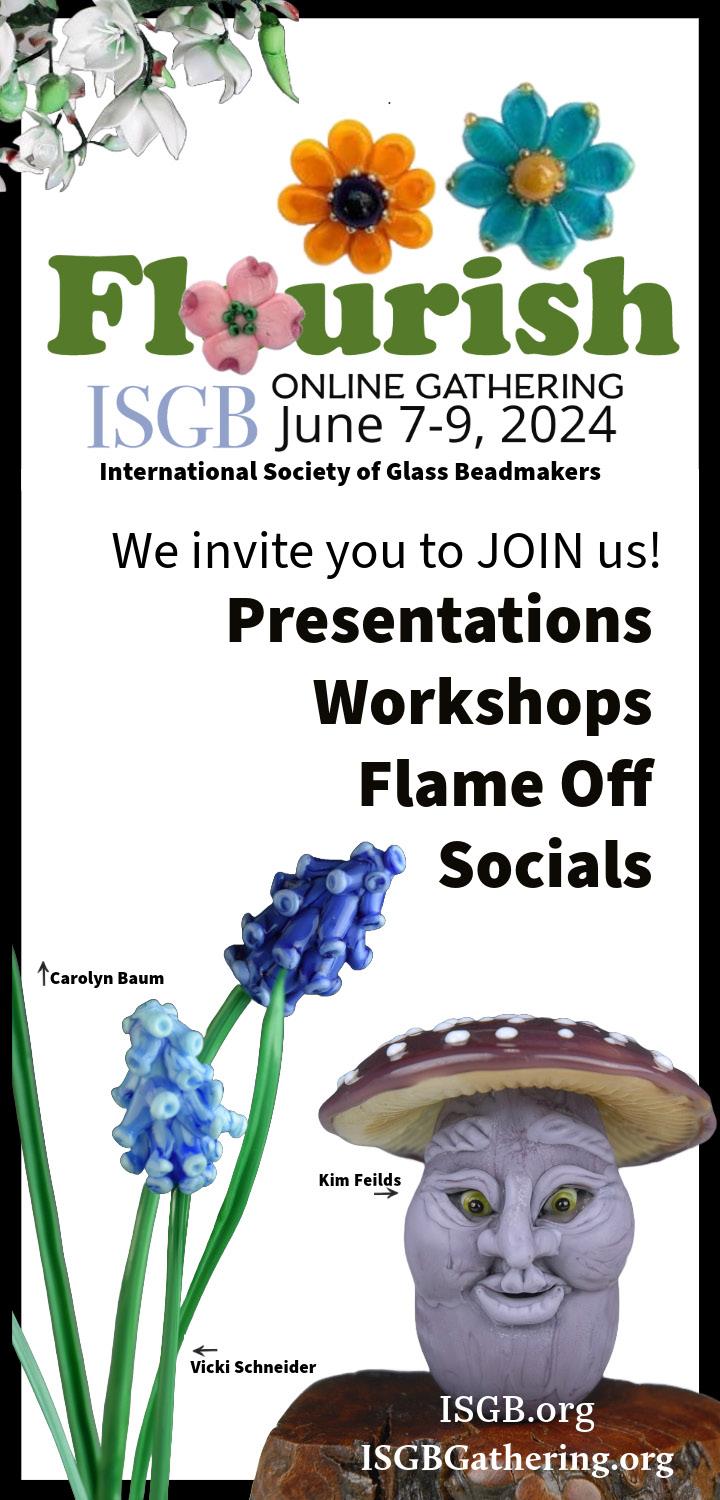
GA S NEWS SPRING 2024 VOLUME 38, ISSUE 1 9
Infinity Vessel, ROBOBALLET. Image courtesy of Sini Majuri.
Amanda Crans is the Communications Manager at GAS.
GLASS DESIGN AND CRAFTSMANSHIP: A CREATIVE DIALOGUE WITH FERRAN COLLADO
by Maria E. Diaz de Vivar
In the vibrant world of glass, where creativity intertwines with tradition, Ferran Collado emerges as an artist who combines contemporary design innovation with the rich craftsmanship passed down through generations. Born in Barcelona in 1980, Collado comes from a family with a rich tradition in glass, dating back to the year 1920. He was raised among family workshops and developed a profound interest in this material from an early age. He learned many of his skills from his father and grandfather, becoming a versatile and passionate glass artist.
After deciding to specialize in certain techniques, Collado traveled throughout Europe and the United States to perfect his craft, working with renowned contemporary glass artists. Currently, he runs his own studio in Barcelona, where he combines various techniques to offer his services to designers, artists, restorers, and glass enthusiasts.
In an exclusive conversation, Collado takes us on a journey through his creative process and the synergy between designers and artisans in the creation of glass artwork. In each response, Collado takes us beyond the shiny surfaces of glass to explore the deep connection between design and craftsmanship in this ancient art. His passion and dedication illuminate the path to a vibrant and creative future for glass art.
Interview
Maria E. Diaz de Vivar : How would you describe your working process in creating glass pieces?
Ferran Collado: Typically, my process starts with a spark of inspiration that can arise at any moment. It could be while working in

the studio or simply experiencing intense emotion. Once I have an idea, I usually sketch out what I want to capture in glass and then begin executing the piece. Often, I encounter technical challenges along the way, but I always strive to adapt and remain true to the original vision.
Maria E. Diaz de Vivar : What types of techniques and skills are necessary for working with glass in a craftsperson manner?
Ferran Collado: Glass craftsmanship is a process that requires a combination of manual skills and technical knowledge. I use basic tools and leverage the gravity,
temperature, and plasticity of glass to shape my pieces. Additionally, mastering techniques such as glass blowing and working on the lathe is essential for creating high-quality pieces.
Maria E. Diaz de Vivar : How do the designs and concepts provided by designers influence your working process?
Ferran Collado: When collaborating with designers, my goal is to capture and materialize their vision in glass. Often, designers have creative ideas that can be technically challenging to execute. In these cases, I face new challenges that push me to explore and expand my skills as a glass artisan.
GA S NEWS SPRING 2024 VOLUME 38, ISSUE 1 10
Portrait of Ferran Collado. Photo courtesy of the artist.

Maria E. Diaz de Vivar : What is the biggest challenge you face when collaborating with designers in creating glass pieces?
Ferran Collado: Each project presents its own unique challenges. From large and complex pieces to unexpected technical challenges, every collaboration challenges me to push the boundaries of what is possible in glass art. However, these challenges are also opportunities for growth and learning.
Maria E. Diaz de Vivar : What aspects of collaboration with designers do you find most rewarding or enriching?
Ferran Collado: The most rewarding aspect of collaborating with designers is the exchange of ideas and the opportunity to work on projects that challenge my creativity and skills. I love seeing the designer's vision come to life in glass and how I can contribute to that process.

GA S NEWS SPRING 2024 VOLUME 38, ISSUE 1 11
Transicions, Casa de les Punxes. Barcelona, 2019. Design: Marta Armengol. Handblown glass by Ferran Collado.
Photo by Carlota Guerreo.
Project: Moritz M-Store. Client: Moritz. Location: Barcelona, Spain. Author: External Reference; Carmelo Zappulla & Chu Uroz. Team: Francesco Sacconi, Javier Alascio. Project Management: External Reference. Collaborators: Oxido Studio, Ferran Collado, D&L Lights, Edgar Dominguez. Photo by Adrià Goula.
Maria E. Diaz de Vivar : Can you share a specific example of a collaborative project you have undertaken with a designer? How was that experience?
Ferran Collado: I'll share some notable collaborative projects. One was for the Moritz Barcelona factory with the "External References" Studio. We created the lighting for the old factory, now a restaurant, using over 100 large glass cylinders. It was a significant technical challenge.
Another project was with designer Marta Armengol. We built a greenhouse on the terrace of a building in the city center using deformed glass tubes. This collaboration was particularly enriching due to the combination of Marta's conceptual design with my artisanal experience in glass. The result was an impressive structure that challenged conventions and captivated all who visited.
Finally, another notable project was for the Bienal de Venecia 2022, in the Catalunya pavilion, in collaboration with Lara Fluxá. The concept of the piece was fascinating: a digestive apparatus simulating the water filtration process of a Venetian canal. This installation incorporated a series of glass tubes representing buoys, allowing viewers to observe the movement of water in a tide cycle. The realization of this project was a technical and artistic challenge that required eight months of intense work, but the final result was truly extraordinary.
Maria E. Diaz de Vivar : How do you think the collaboration between craftsmanship and design contributes to glass art in general?
Ferran Collado: I believe that the collaboration between craftsmanship and design is essential for pushing glass art to new heights. The combination of the designer's creativity and the artisan's skill results in truly exceptional works of art that transcend conventions and captivate the viewer.
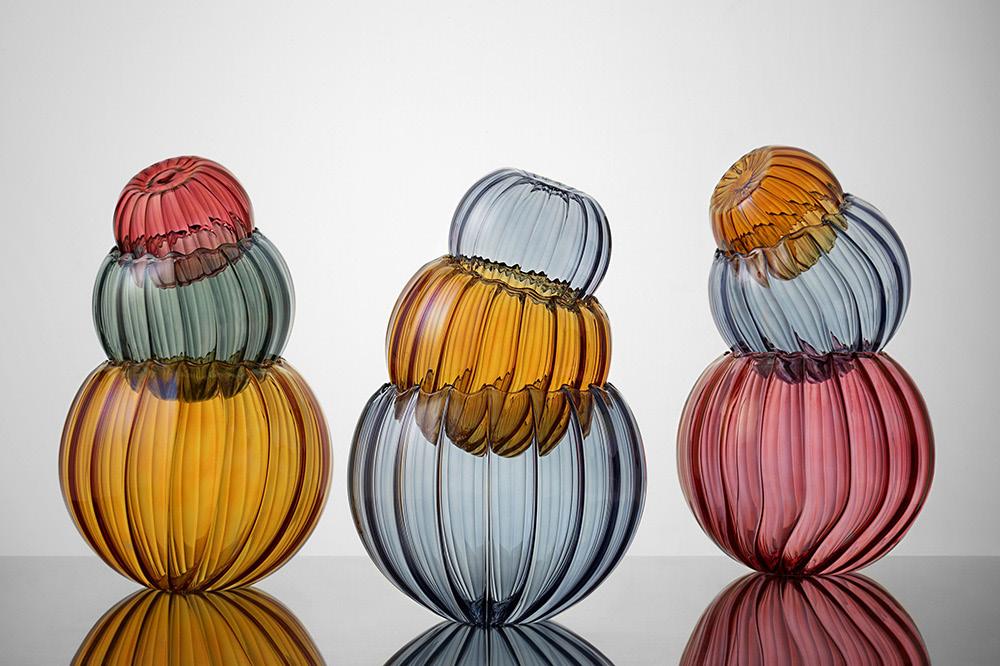
Maria E. Diaz de Vivar : What advice would you give to designers who wish to collaborate with glass artisans on their projects?
Ferran Collado: I would recommend keeping an open mind and being willing to collaborate and experiment. Collaboration between design and craftsmanship is a creative and enriching process that requires patience, communication, and commitment from both parties. I recommend that, when designing something, they identify which glass technique is most suitable for executing that piece, try to find the best specialist in that technique, and then proceed from there. With time, patience, and skill, anything is possible.
María E. Díaz de Vivar is an artist, researcher, writer, and editor. Since 2007 she has directed the publication Objetos con Vidrio, an online platform that disseminates the work of contemporary artists and reflects the activity of artistic glass. She was a member of the Executive Committee for South America, responsible for the local organization linked to the events corresponding to the International Year of Glass 2022. She is part of the Board of Directors of the ACAV (Catalan Association of Glass Arts).











His Glassworks Inc support@hisglassworks.com
828-254-2559
www.hisglassworks.com
GA S NEWS SPRING 2024 VOLUME 38, ISSUE 1 12
Ferran Collado, Fast Collection, Blown glass sculpture with borosilicate, 2022. Photo courtsey of the artist.
DISEÑO Y ARTESANÍA EN VIDRIO: UN DIÁLOGO CREATIVO CON FERRAN COLLADO
María E. Díaz de Vivar
En el vibrante mundo del vidrio, donde la creatividad se entrelaza con la tradición, Ferran Collado emerge como un artista que fusiona la innovación del diseño contemporáneo con la rica artesanía transmitida a través de generaciones. En una charla exclusiva, Collado nos lleva a un viaje por su proceso creativo y la sinergia entre diseñadores y artesanos en la creación de obras de arte en vidrio.
Ferran Collado, nacido en Barcelona en 1980, proviene de una familia con una rica tradición en vidrio, que se remonta al año 1920. Criado entre los talleres familiares, desarrolló un profundo interés por este material desde temprana edad. Aprendió gran parte de sus habilidades de su padre y su abuelo, convirtiéndose en un artista versátil y apasionado del vidrio. Después de decidir especializarse en ciertas técnicas, Collado viajó por Europa y Estados Unidos para perfeccionar su arte, trabajando con renombrados artistas contemporáneos en vidrio. Actualmente, dirige su propio estudio en Barcelona, donde combina diversas técnicas para ofrecer sus servicios a diseñadores, artistas, restauradores y entusiastas del vidrio.
En cada respuesta, Ferran Collado nos lleva más allá de las superficies brillantes del vidrio para explorar la profunda conexión entre el diseño y la artesanía en este arte milenario. Su pasión y dedicación iluminan el camino hacia un futuro vibrante y creativo para el arte en vidrio.
Entrevista
María E. Díaz de Vivar: ¿Cómo describirías tu proceso de trabajo en la creación de piezas de vidrio?

Ferran Collado: Normalmente, mi proceso comienza con una chispa de inspiración que puede surgir en cualquier momento. Puede ser mientras trabajo en el taller o simplemente experimentando una emoción intensa. Una vez que tengo una idea, suelo dibujar un esbozo de lo que quiero plasmar en vidrio y luego comienzo a ejecutar la pieza. A menudo, me encuentro con desafíos técnicos durante el proceso, pero siempre intento adaptarme y ser fiel a la visión original.
María E. Díaz de Vivar:¿Qué tipo de técnicas y habilidades son necesarias para trabajar el vidrio de manera artesanal?
Ferran Collado: La artesanía del vidrio es un proceso que requiere una combinación de habilidades manuales y conocimiento técnico. Utilizo herramientas básicas y aprovecho la gravedad, la temperatura y la plasticidad del vidrio para dar forma a mis piezas. Además, el dominio de técnicas como el soplado de vidrio y el trabajo en torno es fundamental para crear piezas de alta calidad.
María E. Díaz de Vivar: ¿Cómo influyen los diseños y conceptos proporcionados por los diseñadores en tu proceso de trabajo?
Ferran Collado: Cuando colaboro con diseñadores, mi objetivo es capturar y materializar su visión en vidrio. A menudo, los diseñadores tienen ideas creativas que pueden ser técnicamente desafiantes de ejecutar. En estos casos, me enfrento a nuevos retos que me empujan a explorar y ampliar mis habilidades como artesano del vidrio.
María E. Díaz de Vivar: ¿Cuál es el mayor desafío que enfrentas al colaborar con diseñadores en la creación de piezas de vidrio?
Ferran Collado: Cada proyecto presenta sus propios desafíos únicos. Desde piezas grandes y complejas hasta desafíos técnicos inesperados, cada colaboración me desafía a superar los límites de lo que es posible en el arte del vidrio. Sin embargo, estos desafíos también son oportunidades para crecer y aprender.
GA S NEWS SPRING 2024 VOLUME 38, ISSUE 1 13
Retrato. Foto por Ferran Collado.
María E. Díaz de Vivar:¿Qué aspectos de la colaboración con diseñadores te resultan más gratificantes o enriquecedores?
Ferran Collado:: Lo más gratificante de colaborar con diseñadores es el intercambio de ideas y la oportunidad de trabajar en proyectos que desafían mi creatividad y habilidades. Me encanta ver cómo la visión del diseñador cobra vida en vidrio y cómo puedo contribuir a ese proceso.
María E. Díaz de Vivar:¿Puedes compartir algún ejemplo específico de un proyecto colaborativo que hayas realizado con un diseñador? ¿Cómo fue esa experiencia?
Ferran Collado: Te comparto algunos proyectos colaborativos destacados. Uno fue para la fábrica Moritz Barcelona con el Studio "External References". Creamos la iluminación de la antigua fábrica, ahora restaurante, usando más de 100 cilindros de vidrio de gran dimensión. Fue un gran desafío técnico.
Otro proyecto fue con la diseñadora Marta Armengol. Construimos un invernadero en la terraza de un edificio del centro de la ciudad utilizando tubos de vidrio deformados. Esta colaboración fue especialmente enriquecedora debido a la combinación del diseño conceptual de Marta con mi experiencia artesanal en vidrio. El resultado fue una estructura impresionante que desafió las convenciones y cautivó a todos los que la visitaron.
Finalmente, otro proyecto notable fue para la Bienal de Venecia 2022, en el pabellón de Catalunya, en colaboración con Lara Fluxá. El concepto de la obra era fascinante: un aparato digestivo en el que se simulaba el proceso de filtración del agua de un canal veneciano. Esta instalación incorporaba una serie de tubos de vidrio que representaban boyas, permitiendo a los espectadores observar el movimiento del agua en un ciclo de mareas. La realización de este proyecto fue un desafío técnico y artístico que requirió ocho meses de

Projecto:
intenso trabajo, pero el resultado final fue realmente extraordinario.
María E. Díaz de Vivar:¿Cómo crees que la colaboración entre artesanía y diseño contribuye al arte en vidrio en general?
Ferran Collado: Creo que la colaboración entre artesanía y diseño es fundamental
para impulsar el arte en vidrio hacia nuevas alturas. La combinación de la creatividad del diseñador y la habilidad del artesano da como resultado obras de arte verdaderamente excepcionales que trascienden las convenciones y cautivan al espectador.
María E. Díaz de Vivar:¿Qué consejos darías a los diseñadores que deseen
GA S NEWS SPRING 2024 VOLUME 38, ISSUE 1 14
Moritz M-Store. Cliente: Moritz. Locación: Barcelona, Spain. Autor: External Reference; Carmelo Zappulla & Chu Uroz. Equipo: Francesco Sacconi, Javier Alascio. Project Management: External Reference. Collaboradores: Oxido Studio, Ferran Collado, D&L Lights, Edgar Dominguez. Foto por Adrià Goula.

colaborar con artesanos del vidrio en sus proyectos?
Ferran Collado: Les recomendaría que
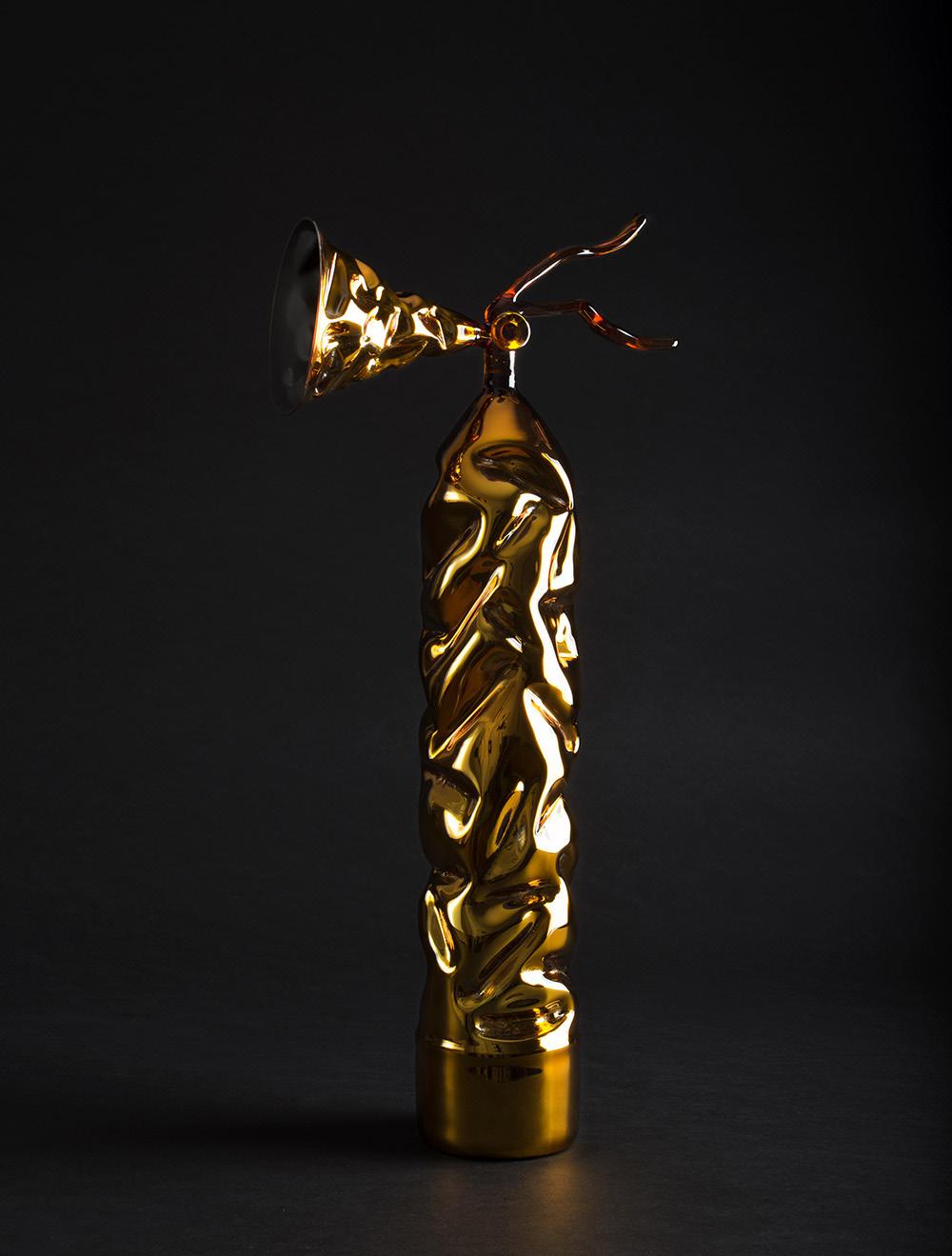
mantengan una mente abierta y estén dispuestos a colaborar y experimentar. La colaboración entre diseño y artesanía es un proceso creativo y enriquecedor que requiere paciencia, comunicación y compromiso por ambas partes. Les recomiendo que primero, cuando diseñan algo, identifiquen que técnica de vidrio es la más adecuada para poder ejecutar esa pieza, intenten buscar al mejor especialista en esa técnica y a partir de ahí, llevarla adelante. Con tiempo, paciencia y un buen hacer, todo es posible.
María E. Díaz de Vivar es una artista, investigadora, escritora, y editora. Desde 2007 dirige la publicación Objetos con Vidrio, una plataforma en línea que difunde la obra de artistas contemporáneos y refleja la actividad del vidrio artístico. Fue miembro del Comité Ejecutivo para Sudamérica Sur, responsable de la organización local vinculada a los even -
tos correspondientes al Año Internacional del Vidrio 2022. Forma parte de la Junta Directiva de la ACAV (Asociación Catalana de las Artes del Vidrio).

GA S NEWS WINTER 2014 VOLUME 25, ISSUE 4 5 S NEWS SPRING 2024 VOLUME 38, ISSUE 1 15
Llim, Bienal de Venecia 2022, vista de la Instalación. Diseñadora: Lara Fluxá. Soplado a mano por Ferran Collado y Lara Fluxá. Foto por Violeta Mayoral.
F erran Collado, Extientor, Escultura de vidrio soplado con borosilicato, 2019. Foto por Ferran Collado.
EARTH ÆNGEL, FLUID FUTURITY IN ART AND DESIGN
By John Erwin Dillard
Earth Ængel (they/ them) is an NB-trans artist whose creations stem from their own gender fluid experience. They navigate fantastical queer ecology and confront the dysphoria of hetero-centric late stage capitalism. In their work they use heat-related practices to melt it all down, employing glass, metal, and bioplastics as tools to express the disillusionment of the binary.
With a BA in Fashion Design from Parsons School of Design and an MFA from Goldsmiths University, Earth Ængel shifts the paradigm of art and design. With a long-term career in food styling and prop management they present a fluid and dynamic expansion between two often siloed worlds. Ængel’s writing, particularly the Dolphin Gurlz saga, provides a new lens through which glass can disrupt the boundary between form, function, and utility. The artist’s approach to the centuries-old tradition of stained glass catalyzes a new fantastical world view in which the Dolphin Gurlz exist.
The Dolphin Gurlz series postulates an existence where fluidity is the only constant. Dolphin Gurlz restructures the current methodology around knowing. They provide for us a world to inhabit in a time of un-knowing. In this new space, the need for boundaries becomes antiquated. Through this lens, Earth Ængel can effortlessly slip between the spheres of art and design.
Pedagogically we understand design as a way of living or inhabiting through objects. Items with a utilitarian purpose are glamorized, modified, and altered to affect our aesthetic sensibilities, whereas the art object is historically devoid of any practical usage. Works of art have a purpose, and design objects have function. In the universe of the Dolphin Gurlz these distinctions vibrate, beginning to overlap and allowing for slippage between world
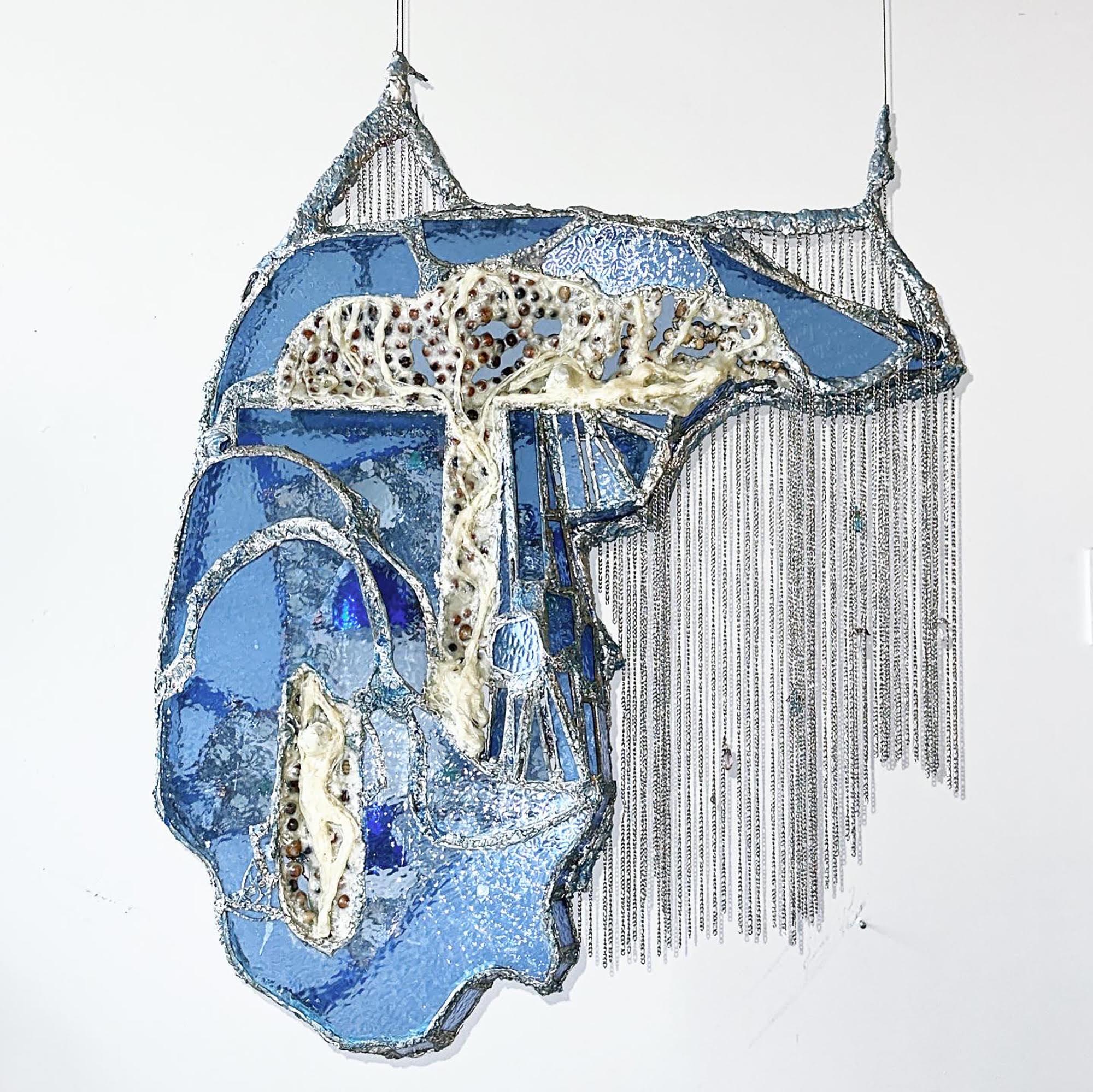
Earth Ængel, S(he) / They / Ocean/ Tree, Pt.2 TRANS Mundi, stained glass, solder, jewelry chain, resin-clay, crystal angel beads, LED water tornado that sparkles, shells, glass beads, wood beads as a tree, and swimmer figures made out of a rosin based bioplastic (body wax) with mica and perfume; suspended by cable, 2023. 4-6' extendable in height x 27" Wx 6" D. Photo courtsey of the artist.
and dimension. Within this alternate plane, empirical expectations of stained glass blurs with elevated adaptations of the process into something wholly new.
Earth Ængel harnesses the energy of these hybridized creatures to destabilize our current understanding of objecthood. What we traditionally recognize to be true about stained glass, its inert and static placement within windows, is flipped upside down. Ængel undermines the typically immobile presentation of stained glass into charged sculptural objects. Where we would expect to see polished beads of solder, Ængel substitutes for freeform three dimensional attachments.
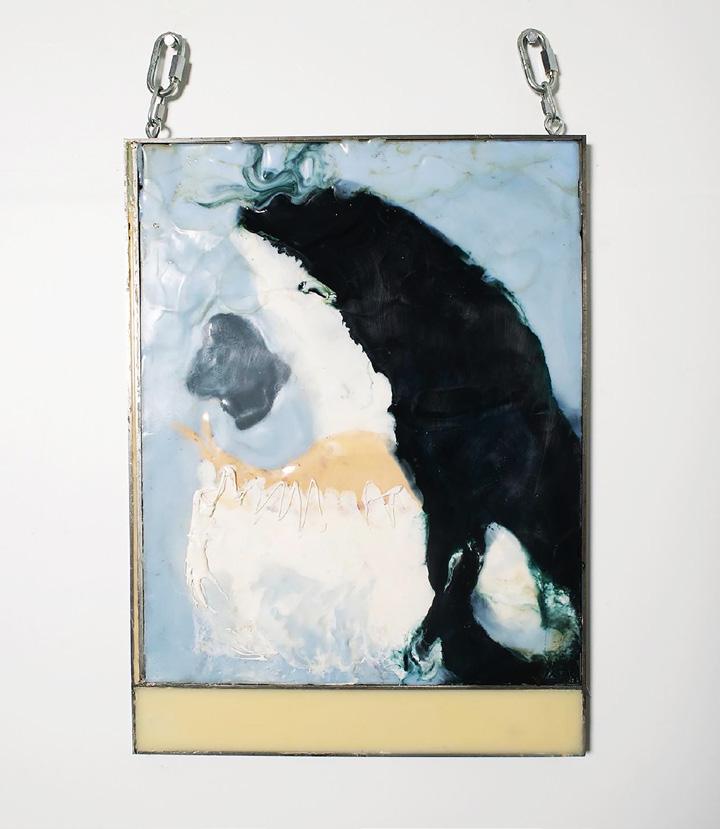
GA S NEWS SPRING 2024 VOLUME 38, ISSUE 1 16
Earth Ængel, Every-bodies Got To Eat, rosin based bioplastic scented body wax with mica, Lipstick, resin bar, in steel frame. 36”x24”x1”. Photo courtsey of the artist.
The artist wields the soldering iron akin to a paintbrush. Using pewter, flux, and an iron they weave their sculptures into dimensionality with expert craftsmanship. To the untrained, these lines could appear crass or tentative, but are fundamental choices in the artist’s incredible sensibility. These works further blur the distinction between the objects of art and design. With an invigorated energy they breathe new life into an age-old technique. Their energy has reanimated the capacity of stained glass to awaken the spiritual within us. The potential of these works opens a new pathway to reinterpret what we know of design, allowing viewers a space to understand that it is not an either/or situation, but that it is possible for both methodologies to exist simultaneously. Ængel’s work reminds us all that fluidity, as a way of seeing, can grant us new and necessary perspectives through which to learn and know.
Our most lauded historical examples of stained glass are situated in houses of worship. The grand windows of cathedrals and churches have towered over the congregations for centuries, crafted to awe the masses in the splendor and might of godly power. These windows were made with the illiterate in mind, to tell the stories of divine teaching. Allegories, like the Stations of the Cross, are illuminated in fixed geometric positions. Constructions like Chartres Cathedral can teach us much of stained glass’ functionality in the past. One finds collections of panes are all grouped in formal systems of shape and narrative. The rows of windows, in which evenly spaced groupings of circles, medallions, and quatrefoils are dedicated to the Incarnation of Jesus, command central placement. Lancets spread perpendicularly; each swordlike pane of glass dedicated to the life of a specific saint. These luminous worlds are limited by their stone borders. Context, design, and placement is dictated firstly by the building they inhabit.
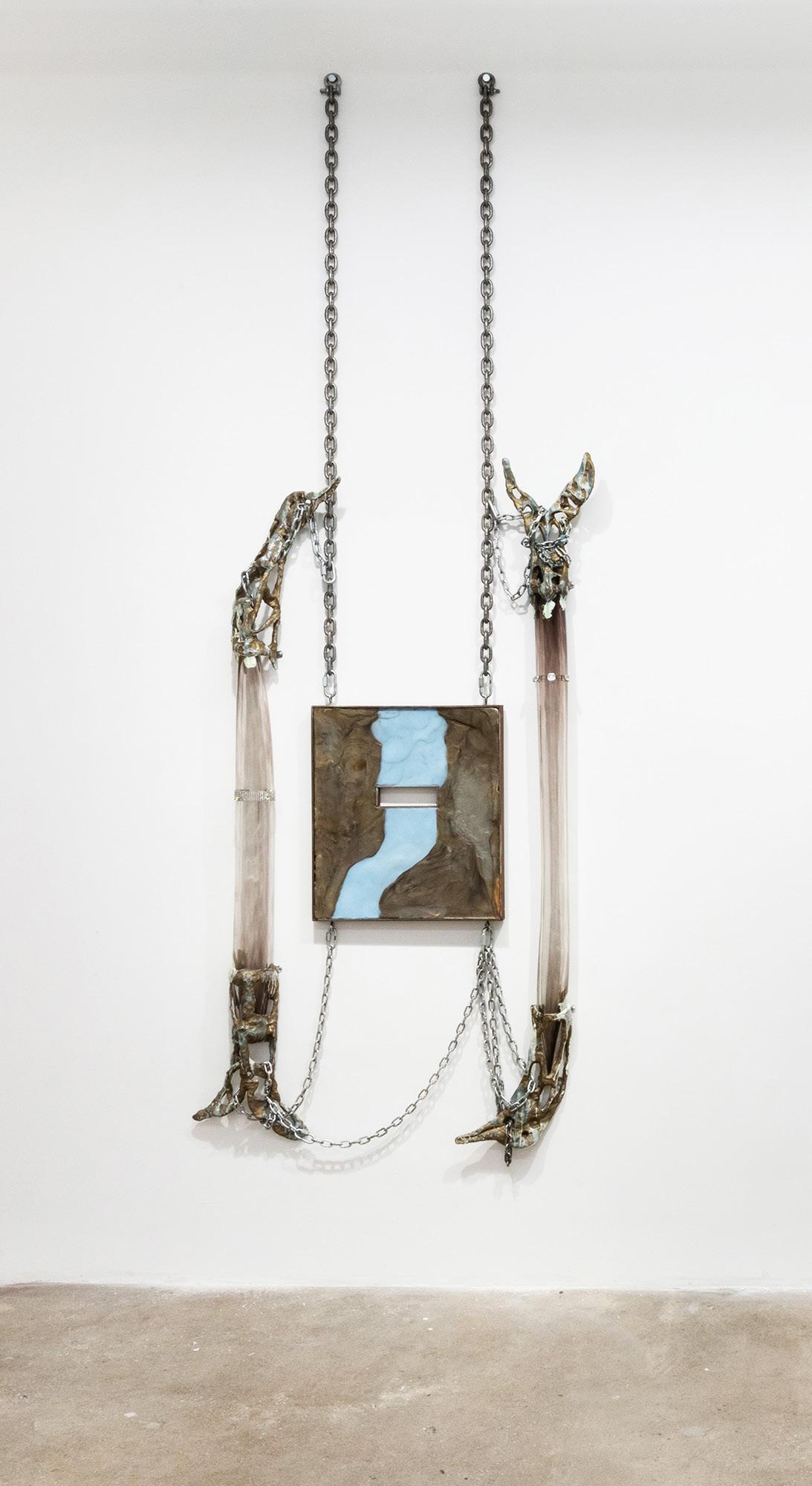
GA S NEWS WINTER 2014 VOLUME 25, ISSUE 4 5 S NEWS SPRING 2024 VOLUME 38, ISSUE 1 17
Earth Ængel, Dolphin Gurlz ETERNAL, blown glass, metal frame, chain, Japanese rock crystal jewelry, swarovski choker, rosin bas ed bioplastic (body wax), mica, resin-clay, 2021. 9' H x 33"W x 4"D. Photo courtsey of the artist.
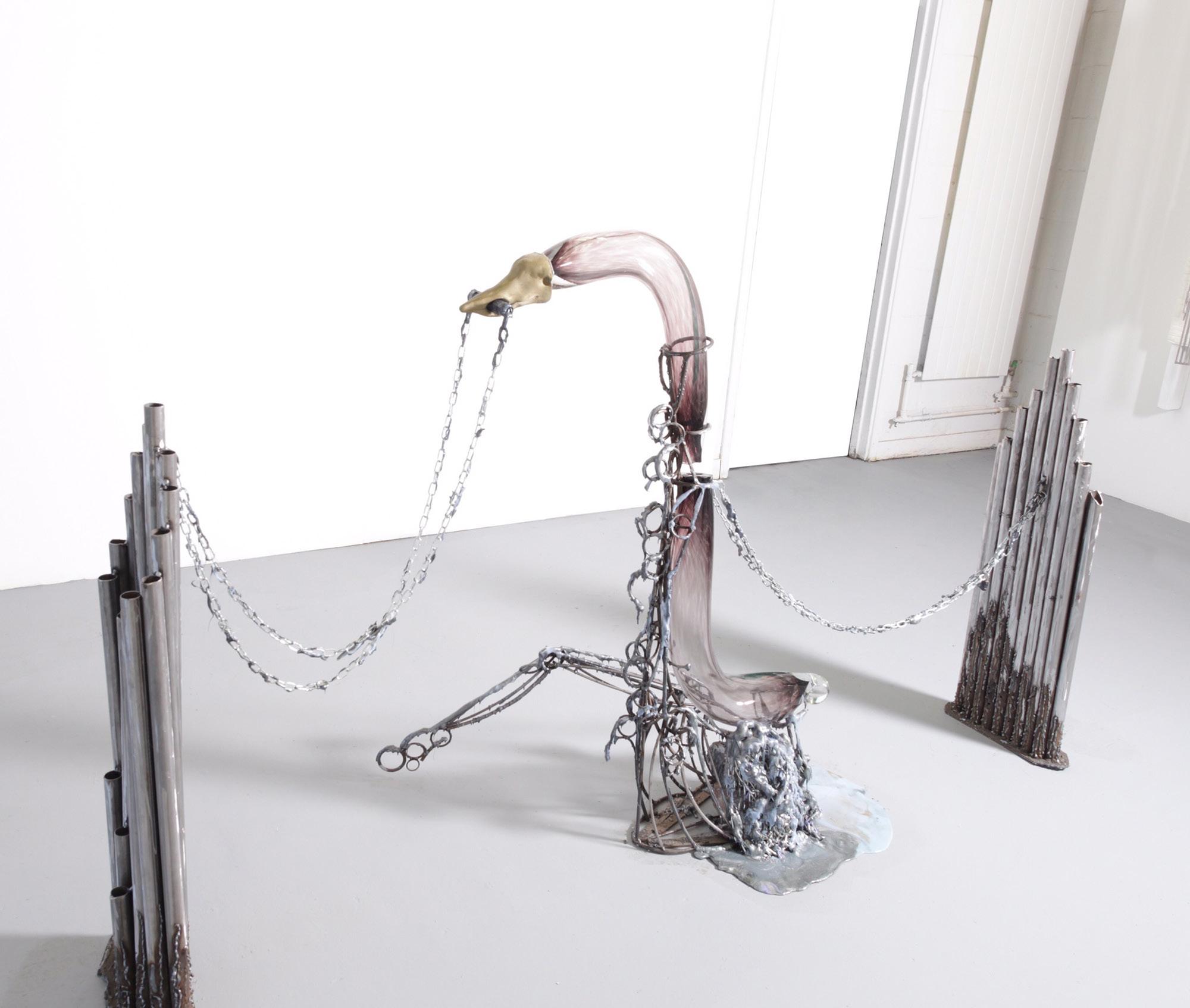

Ængel’s work breaks this linear system to move the medium beyond the formal constrictions of architecture. There is an embodied sense of movement from their pieces, even when viewing them through the lens of the printed image. The Dolphin Gurlz hang with dimensionality, a sense of delicate fluid weight that is inescapable. The edges begin and end with unexpected nimbleness. In each artwork, a brightness of mixed metallics, seemingly untethered, layer with a mysterious shine. These are light and inviting, they weave a new pathway to knowledge. A reversal of how we typically understand knowing: open ended and amorphous.
The undulating, often crude, yet glamorous sculptures open a new window. Each work exists as a portal into this miraculous nonbinary system. Through this fluid aperture we may catch quick glances into Ængel’s visions of fluid futurity.
John Erwin Dillard. B. Gulfport, MS, USA 1995. May generosity exist in us.






GA S NEWS SPRING 2024 VOLUME 38, ISSUE 1 18
wissmachglass.com sales@wissmachglass.com 1-304-337-2253 Paden City, WV @wissmach_glass @wissmachglass American made in West
NEW COE 96 Colors 96-197 LL 96-WO 191 96-76
Virginia since 1904
Earth Ængel, Dolphin Gurlz 4EVER, blown glass, metal rod stand, metal pipe organs, chain, crystal locks, rosin based bioplastic (body wax), mica, resin, and bricks, 2019. 29" W x 55" H x 6-9' extendable. Photo courtsey of the artist.
Earth Ængel, Dynasti, blown glass, metal, Rosin based bioplastic (body wax), mica, chain, resin, brass chimes, shells, driftwood, and string, 2019.5'H x 38"L x 4"D. Photo courtsey of the artist.
GLASS FASHION TAKES CENTRE STAGE
By Kehinde Adepetun
Imagine a dress of glass shimmering like moonlight on water, its ethereal folds catching the light and revealing glimpses of skin beneath. This stunning reality transcends the boundaries of traditional fashion, introducing us to the interesting world of glass fashion. It is crucial to understand that this is not merely about clothing—it is a transformative journey where glass and fashion converge, pushing the limits of what we wear and challenging our perceptions of artistic expression in everyday life.
In this unique world of glass fashion, spectacular creations from artists like Chelsea Rousso and Iris Van Herpen redefine our understanding of clothing and push the boundaries of creativity. Chelsea Rousso, an award winning glass fusion artist and fashion innovator, offers insights into the delicate artistry of working with glass as a fashion medium.
Working with glass as a fashion material naturally challenges our usual ideas about clothing. "It blurs the lines between fashion and art," explains Rousso, "encouraging a reconsideration of what we wear and how we perceive the intersection of clothing and artistic expression in our daily lives." Nevertheless, creating wearable pieces with glass comes with its own set of hurdles. As with many haute couture pieces, these glass designs are more works of art than practical clothing. Rousso describes it as a "subtle interplay" between crafting something beautiful and ensuring it is functional and durable.
Transforming a sheet of fused glass into a garment requires meticulous planning and skilled craftsmanship. First, a mold is carefully crafted based on specific body measurements. Secondly, a pattern is then drafted, the glass assembled with the perfect balance of color, line, texture, and proportion before being fused into

the desired form. The molten glass plate is then carefully positioned on the mold, where it begins the slumping or draping process. Success hinges on precise execution—if all goes according to plan, the glass takes on the shape of the mold, resulting in a breathtaking wearable creation. The final touches, including straps and embellishments, require further attention to detail in order for it to materialize into the design.
Inherent contradictions often spark captivating beauty. Glass fashion wears exemplifies this perfectly, striking a balance between delicate fragility and bold, statement-making design.
"Wearable glass art can be coarse and unrefined or polished to immaculate
perfection; sensuous and seductive or sharp and dangerous," says Rousso. Her work explores the concept of "reveal yet protect," often featuring transparent glass shields that offer a sense of protection while remaining completely see-through. This harmony between vulnerability and strength is undoubtedly the hallmark of glass fashion.
While it may seem like a niche within the broader fashion world, glass fashion has the potential to leave a lasting mark. Rousso's pieces are more than just garments; they are stories waiting to be told, fostering an "intimate dialogue between the artistry of glass, the person who wears it, and their social identity." She observes a growing trend of "clothing
GA S NEWS WINTER 2014 VOLUME 25, ISSUE 4 5 S NEWS SPRING 2024 VOLUME 38, ISSUE 1 19
Aqua Glasskini, photo courtesy of the artist.

as identity," where fashion becomes a tool for self-expression, and glass serves as a unique medium to explore personal narratives and individuality.
Glass’ delicate and brittle nature challenges conventional notions, offering a shift in how we perceive and interact with fashion materials. It contrasts with common fabrics, emphasizing careful handling and an awareness of movement, disrupting the soft and pliable expectations associated with traditional clothing materials. Glass, by its very nature, stands in stark contrast to the common fabrics and textiles used in fashion. Its fragility challenges conventional notions of clothing, demanding a shift in how we interact with our attire. "The fragility of glass necessitates a shift in how we perceive and interact with our attire, emphasizing careful handling and an awareness of our movements," explains Rousso.
The "glasskini," a bikini crafted from molded glass, complete with shimmering charms that jingle as the wearer moves, perfectly encapsulates the playful and unconventional nature of this art form, highlighting the innovative use of glass in fashion. This playful defiance of expectations is what makes glass fashion so captivating.
The creation of glass fashion is a fascinating and collaborative process. Rousso's journey from fashion designer to glass artist exemplifies this spirit. She highlights the importance of collaboration between artists, artisans, and various specialists. A successful glass fashion show, for instance, requires the combined talents of photographers, stylists, models, makeup artists, musicians, and lighting specialists, all working together to bring the magic of glass to life. In 2022, the Believe the Impossible: Glass Fashions in Wonderland show hosted by Wiener Museum of Decorative Arts was a
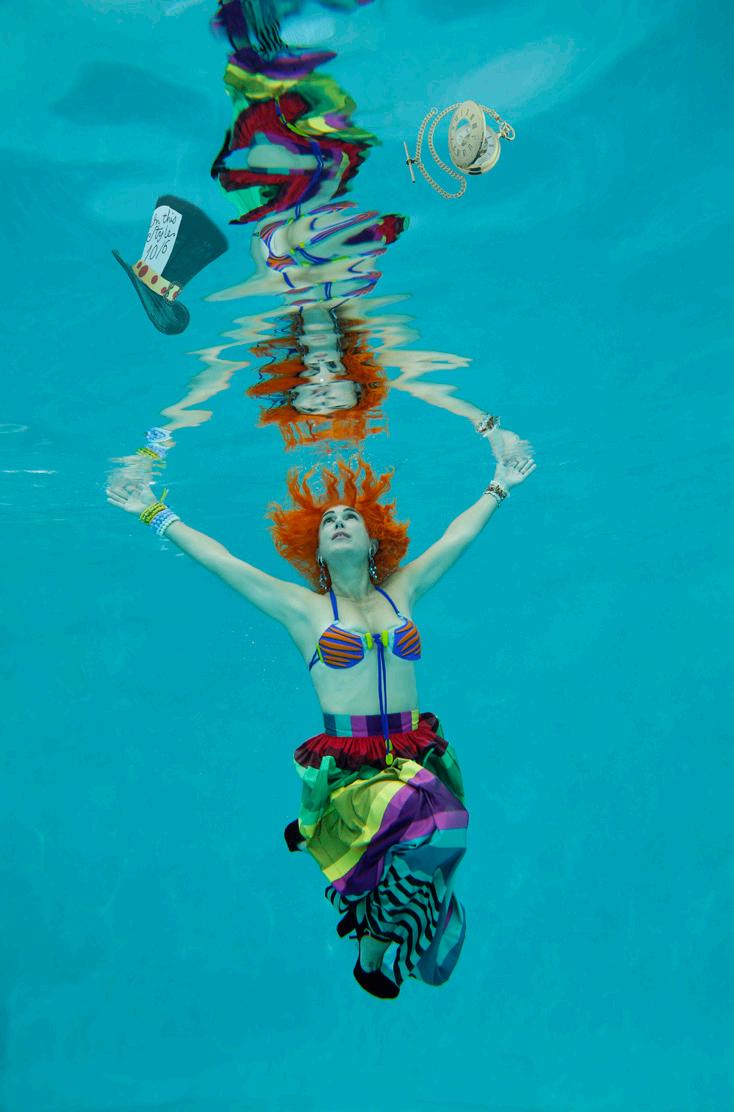
GA S NEWS SPRING 2024 VOLUME 38, ISSUE 1 20
Mad Hattress (underwater). Photo by Suzanne Barton.
fragile, TestTubes. Photo by Humberto Vidal.
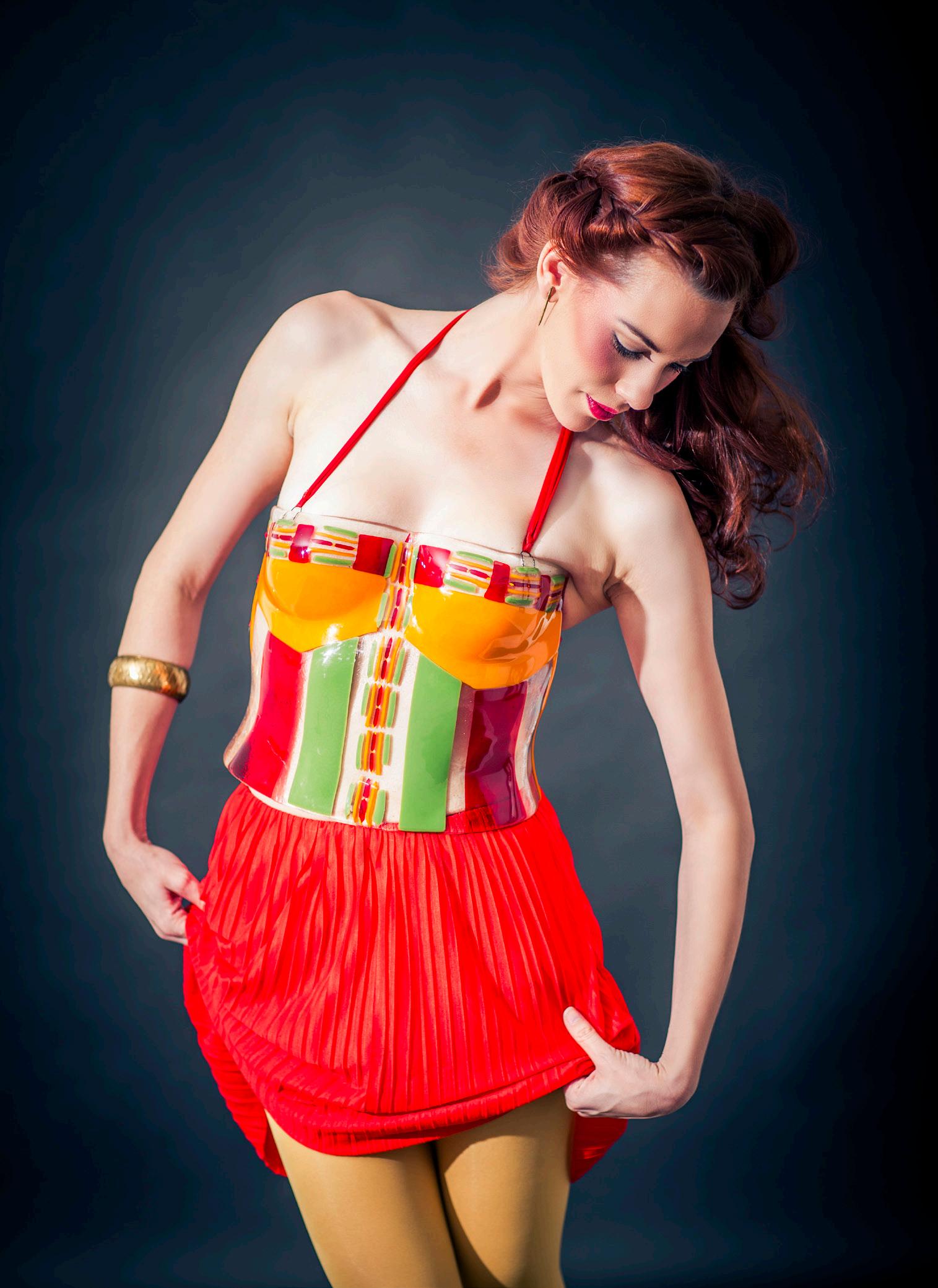
successful example of artisans supporting each other, and is a testament to the power of collaboration in this art form.
Through her wearable art and educational initiatives, Rousso aims to leave an indelible mark on the world of fashion and glass art, one that encourages boundless creativity.
As glass fashion continues to emerge as a fascinating intersection between worlds, it not only tells individual stories but also influences broader trends, leaving a
lasting legacy that stretches far beyond the realm of traditional clothing. It is not just a garment; it is an innovative art form that defies expectations and invites you into the mesmerizing world where art and fashion converges.
Kehinde Grace Adepetun is a freelance writer with a passion for delivering engaging narratives. She has contributed insightful articles across various publications, showcasing her ability to delve into diverse topics.

GA S NEWS WINTER 2014 VOLUME 25, ISSUE 4 5 S NEWS SPRING 2024 VOLUME 38, ISSUE 1 21
Agent Orange Corset.
Photo by Humberto Vidal
A TWO-WAY MIRROR: EXHIBITION REFLECTS RACIAL REALITIES
By Danielle Hayden
Of the world's glass artists, it is estimated that less than 1% identify as Black. A recent exhibition called A Two-Way Mirror : Double Consciousness in Contemporary Glass by Black Artists (at the Museum of Glass in Tacoma, WA until October 2024) is the first of its kind and includes the works of 23 Black artists from both the U.S. and abroad. The title is a nod to the late, renowned African-American scholar W.E.B. Du Bois' concept of "double consciousness," which refers to an aspect of the Black experience in America: a divided consciousness between how one sees oneself and how one is simultaneously being perceived by the world. Pieces made solely of glass and other mixed media artistic works that are in conversation with identity comprise A Two-Way Mirror.
Curator Jabari Owens-Bailey's choice to first propose this artistic direction and then pursue found its genesis through a desire to see more of himself represented in glass work and to bring that to the public. Owens-Bailey, who also holds the title of Curatorial Education Program Manager at the museum and is an artist and designer in his own right, set out to explore identity through glass. The Corcoran School of the Arts and Design in DC and School of Visual Arts graduate sought contributions from near and far, contacting artists themselves, other art institutions, and auction houses to assemble the robust collection. Some works came from the Museum of Glass' own collections, many by artists-inresidence who leave a piece behind that becomes a permanent part of the museum.
The exhibition is housed in the main gallery and occupies four rooms, each of a different color and imbued with its own sense of meaning and valence. Just as

there were many conversations around which work would be selected and shown, there were likewise many discussions about the exhibition's structure itself.
"I wanted to address this idea of identity through four different parts of the exhibition," says Owens-Bailey. “So there is a Mind, a Body, a Spirit, and a Perception section." The Perception section, adjacent to the title wall, incorporates sculptures that depict Black bodies by glass artists who are not Black themselves, and some of those depicted Black bodies have stereotypical racialized features. There is also a glass cologne bottle patterned after the design of a small medallion that abolitionists would carry, in the shape of a prostrating slave. The medallion reads, 'am I not a man, am I not a brother?'
The Spirit portion of the exhibition, whose walls bear a deep purple hue, deal with Black spirituality. There is a large piece
by Puerto Rican artist Alejandro Guzman that references Palo, an African diasporic religion; tall and made entirely of reflective glass. Another piece is about an invented mythology: called "Fire Breather" by Barbara Earl Thomas, it is made from solid and hand-blasted glass in the shape of a vase with red and orange hues, with clear ornate pieces that seem to come alive as they emerge from the mouth of the vessel. There is also a mirror, to the left of which are printed questions such as "How do you see yourself?" "How do you see your identity?" and "What does double consciousness mean to you?" Visitors are invited to draw or write on the mirror with their answers.
Next to this is a reading area with texts related to A Two-Way Mirror. Some of the books are about the artists themselves, while others are more academic, such as The Souls of Black Folk—which contains the origin of DuBois’ notion of double consciousness.
GA S NEWS SPRING 2024 VOLUME 38, ISSUE 1 22
Young girl, age 7, looking at self in mirror near beginning of exhibition. Photo by Danielle Hayden.

The middle section is the Body section. That section is painted brown to represent brown bodies and features works like "Strange Fruit," made by U.K. artist Chris Day of blown and sculpted glass with steel, hessian cord, and reclaimed electrical wire suspended from overhead, bringing to mind Billie Holliday's haunting 1939 song about lynching. "Here, you will find [art that] almost functions as a proxy for the Black body," says Owens-Bailey.
The final section is the Mind section, which contains more conceptual frameworks of Blackness, history, and ideas of aesthetics. The exhibition, in some places, seems to subvert the dominant paradigm of design vis-à-vis glass: featured artist and Museum resident Leo Tecosky, for example, uses graffiti in his glass art, which certainly challenges those who

GA S NEWS WINTER 2014 VOLUME 25, ISSUE 4 5 S NEWS SPRING 2024 VOLUME 38, ISSUE 1 23
Reading table and mirror for museum visitors, curated by Jabari Owens-Bailey, 2024. Photo by Danielle Hayden.
Chris Day (British, born 1968). Strange Fruit, 2018. Blown and sculpted glass with steel, hessian cord and reclaimed electrical wire; Dimensions vary. Courtesy of the artist and Vessel Gallery, London. Photo by Danielle Hayden.
may consider themselves purists. He has a rich background in blacksmithing and using industrial materials, and his work often tends toward the countercultural.
Cheryl White of Glass Wheel Studio says of Tecosky: "[He] juxtaposes the complexity of visual language with the fluidity and transparency of glass … his work reflects cultural exchange and the mathematics within archetypes.” Tecosky incorporated a new form that he hadn't really worked on before, which is the cloud form, like a spray or smoke cloud, often an aesthetic component of graffiti art. He also wanted to sculpt newer, complex forms of glass while different components were hot.
The only work in the exhibition that is not made out of glass is found here, by Related Tactics and originally a part of their 2022 exhibition Disclosure: Whiteness of Glass. On the wall is a pie chart showing the lack of diversity in glass art. That pie chart is intentionally surrounded by a black space, because Related Tactics elected not to center whiteness—a pushback against the status quo. The final wall is also covered with bold phrases of equity, all in black and white and linear—as unambiguous in their aesthetic as in their wording. Phrases like "Make justice-oriented pathways to artistic and studio resources." and "Pay a living wage." leave museum visitors with much to think about as they exit the exhibition.
Owens-Bailey has put together work by both established and emerging artists (one of whom, young Nigerian artist Layo Bright, had her first showing in glass via this exhibition with her kiln-formed glass pieces called Adebisi I and Adebisi VII ), which was another very deliberate choice: "I thought the interplay between those artists that are more established already and these burgeoning artists creates interesting conversation, and that conversation hopefully is a doorway. And I think one of the things that I want this exhibition to be about is to give opportunities to artists of color who are not necessarily always working in this medium, but they have used it and exploited it for properties of glass


GA S NEWS SPRING 2024 VOLUME 38, ISSUE 1 24
Leo Tecosky (American, born 1981) Untitled, Made at the Museum in 2022. Blown, cut and enameled glass; 16 1/2 × 12 × 3 3/8 in. Collection of Museum of Glass, gift of the artist. Photo by Danielle Hayden.
Therman Statom (American, born 1953). Ladder, 2012. Blown glass and mixed media; 76 × 15 × 6 3/4 in. Collection of Museum of Glass, gift of the Robert M. Minkoff Foundation.
Photo by Danielle Hayden.
in oftentimes very sophisticated ways," says Owens-Bailey. Aside from its obvious artistic merits, then, A Two-Way Mirror can also serve as an invitation, beckoning more artists of color to this rich milieu.
Glass, Owens-Bailey believes, is a material that is rich both in its own inherent history and metaphorical potential—metaphors of metamorphosis and transparency. He has said that he wants to go beyond pure formalist aesthetics or presenting glass as merely a viable option. "I think due to the nature of glass … it is already a seductive material, but I also think it has very rich potential in its usage in terms of the fact that it can be opaque, it can be translucent, you can abrade the surface of it, it can become sandblasted, it can be etched, it can be reflective and all of those things… [It is] rich [in] metaphors to kind of explore and kind of get into larger ideas of personhood. So because of that I thought it was a very apt material to kind of talk about how one sees themselves and how the world around them sees them."
The exhibition seeks not only to highlight the dearth of glass artists in the African diaspora, but also helps to bridge a gap, responding to the paucity of information about Black artists who use this medium. At the same time, the exhibition is amplifying the talent of unsung creatives and introducing museum patrons to creatives they may not necessarily have been exposed to before, and may never have been otherwise. The Glass Museum has been striving to view more of its own work through a social justice lens, and this mission holds broader implications for inclusivity in the art world. One might conclude that A Two-Way Mirror, then, is helping some break through a different type of glass ceiling.
Danielle Hayden is a Seattle-based writer interested in multiple genres and artistic disciplines. daniellehayden.com X: @ wordsaremything

GA S NEWS WINTER 2014 VOLUME 25, ISSUE 4 5 S NEWS SPRING 2024 VOLUME 38, ISSUE 1 25
Radcliffe Bailey (American, born 1968). Blue Black, 2016. Glass and ink. 61 × 53 × 13 in, courtesy of the artist and Jack Shainman Gallery, New York. Photo courtesy of Museum of Glass.
MEMBER SPOTLIGHT: IVAN LAMBROV
Ivan Lambrov, born in Bulgaria in 1963, has had a remarkable career in glass art. Growing up surrounded by the cultural richness of his homeland, Lambrov's passion for art blossomed early. His unique artistic journey and his exploration of various mediums eventually led him to the captivating world of glass.
Educated at the prestigious National Academy of Fine Arts in Sofia, Lambrov developed his expertise in mural painting. His body of work from this time encompasses paintings, mosaics, and frescoes. It was also during his academic years that he delved into the world of stained glass—a pivotal experience that laid the groundwork for his later mastery in creating cast glass sculptures, fused glass paintings, and smalti mosaics. The structured yet fluid nature of Lambrov's artistic evolution is a testament to his fusion of formal education, personal inspiration, and a lifelong commitment to the art of glass.
In 1992, he established his art glass studio in Plovdiv, Bulgaria, equipped to facilitate the creation of art glass. Specializing in architectural art glass, the studio collaborates with architects, corporate entities, and private clients, resulting in artworks that grace public spaces with their aesthetic appeal.
Lambrov's creative explorations led him to art forms not related to the architectural environment, inspiring the inception of his cavaletto art. In his paintings, he began using glass as a medium, transforming his oil canvases and watercolors into fused glass paintings with equal expressiveness. This innovation, along with his mastery of cast glass learned at the Bild-Werk International Summer Academy, expanded the horizons of his expression.

Lambrov's artistic development was further enriched through participation in master classes led by prominent artists. Notable among these experiences are the sessions with Max Jacquard in 2011, where he explored kiln casting and glass sculptures. In 2012, Lambrov engaged in a transformative workshop with Stephan Paul Day and Niko Wahl, focusing on collage, glass, and bronze casting. Subsequent master classes in 2013, again with Stephan Paul, delved into the nuances of glass and bronze casting. This education and experience have undeniably shaped Lambrov's artistic trajectory, contributing to the dynamic evolution of his work in the realm of contemporary glass art.
Influenced by enchanting landscapes, mountainous beauty, submerged seascapes, and sea life, Lambrov found inspiration in the intricate details of nature. These influences form the cornerstone of his distinctive artistic style, blending ancient mythological themes with a deep connection to the elements of the earth.
Lambrov's artistic style is a fusion of vivid color palettes, intricate textures, and profound conceptual depth. In his paintings, the marriage of colors and textures harmonizes with the artist's conceptual vision, conveying a rich message to viewers. Despite their two-dimensional nature, Lambrov employs a three-dimensional technique, inviting observers to sense the depth of space and the images within. The
GA S NEWS SPRING 2024 VOLUME 38, ISSUE 1 26
Ivan Lambrov, Composition in Red. smalt mosaics. 39 x 39 inches. Photo by Ivan Lambrov.
paintings come alive, evoking a spectrum of perceptions, feelings, thoughts, associations, and emotions—an embodiment of abstract expressionism.
Abstract expressionism is also evident in his mosaics, despite the decorative nature imposed by the medium.
His sculptures, often possessing volume on all sides, manifest zoomorphic, anthropomorphic, or lithospheric rock forms. Frequently, a combination of these forms emerges, intricately tied to the conceptual intent of each piece. A distinctive feature is the pronounced relief, mirroring natural forms and embodying the multilayeredness of conceptual design. Mythological subjects and ideas interweave in layers, with rough sides intentionally left to enhance the play of light on the relief forms. Lambrov's sculptures exude mystique, transporting viewers to an ethereal realm. The color schemes vary, ranging from monochromatic elegance to a harmonious blend of vibrant hues. In Lambrov's glass art, sculpture becomes a synthesis of his artistic talent, inviting audiences to explore the intricate tapestry of his creative imagination.


Ivan Lambrov's creative process reveals an in-depth exploration of his artistic journey. Here is what the artist says:
"It all starts with a drawing. When tasked with creating a painting, I develop a color sketch using watercolor, a combination of watercolor and acrylic, or through collage with color papers and acrylic. Multiple projects are generated, and I carefully select the one that aligns most closely with my vision. I enlarge the chosen sketch to my selected scale and I start cutting the glass. The painting undergoes several firings in the kiln, with layers of glass and enamel added at each stage.
"Similarly, the process for mosaics mirrors that of paintings. Following the same project steps and design stages, enlarging the design to the actual mosaic size, the arrangement of modules becomes a joyful exercise.
GA S NEWS WINTER 2014 VOLUME 25, ISSUE 4 5 S NEWS SPRING 2024 VOLUME 38, ISSUE 1 27
Ivan Lambrov, Musical Theme, Fused glass painting. 15,74 x 15,74 inches. Photo by Ivan Lambrov.
Ivan Lambrov, A Summer Solstice Ritual, Fused glass painting. 24 x 19 inches. Photo by Ivan Lambrov.
"The creation of glass sculptures is a more elaborate and time-intensive journey. I begin by producing several drawings of the form, each presenting a distinct perspective. In these preliminary sketches, decisions are made regarding color, polished surfaces and textured areas. Enlarging these drawings to the actual sculpture size, I start working with clay. After shaping the clay to completion, I transform it into a wax form. The wax copy is then cast in a refractory mold, and once the wax evaporates within, I cast the chosen glass. Emerging from the kiln, the sculpture undergoes a final polishing."
Ivan Lambrov's creative process is a symphony of artistic vision, technical skill, and a profound connection with the transformative nature of glass as a medium. Works by Ivan Lambrov can currently be seen in three galleries in Bulgaria - Inhom Art Glass Gallery in Varna, Gallery Finesse in Sofia and Aspect Art Gallery in Plovdiv.




GA S NEWS SPRING 2024 VOLUME 38, ISSUE 1 28
Ivan Lambrov, Tales from Maroneia – Legend of Torrone, Kiln cast glass sculpture. 11,4 /h/ x 8,1 x 3,7 inches. Photo by Dimitar Bosakov.
Ivan Lambrov, Tales from Maroneia – Legend of Torrone, Kiln cast glass sculpture. 11,4 /h/ x 8,1 x 3,7 inches. Photo by Dimitar Bosakov.
Bergstrom-Mahler Museum of Glass seeks artists working in glass for two events in 2024: Catching Fire is an online and virtual auction of glass art, June 5–15, 2024. Email stoll@bmmglass.com to





country, August 9–10, 2024.
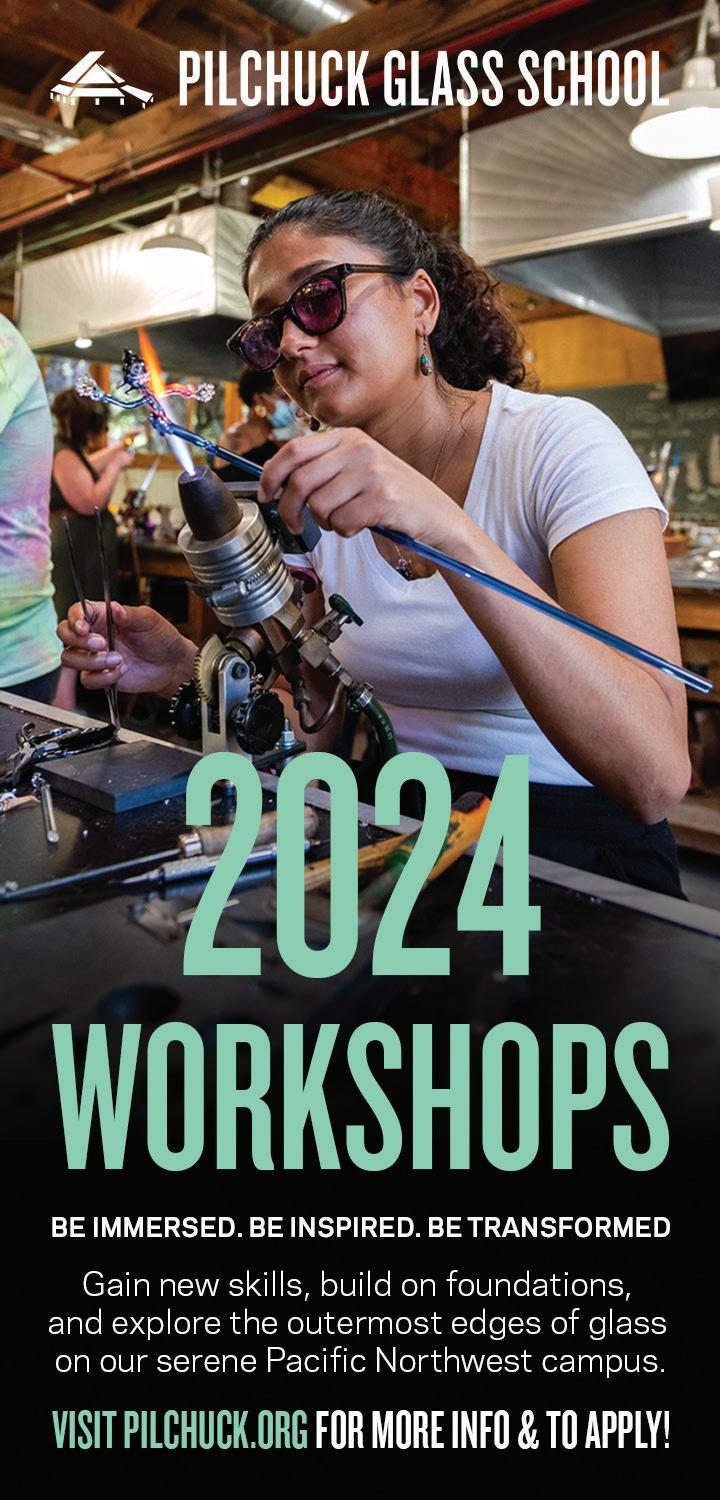
To access the Glass Art Society’s up-to-date opportunities, just click on the links below. GAS OPPORTUNITIES CALLS FOR ENTRY JOB POSTINGS CLASSES + WORKSHOPS AWARDS + NOMINATIONS EXHIBITIONS EVENTS Understand More In the pages of Glass: The UrbanGlass Art Quarterly, leading artists, critics, curators, and academics discuss the artwork, their lives, and the issues facing the field of glass art with insight and analysis unavailable anywhere else. Subscribe to the magazine of record today and don’t miss a single issue. SUBSCRIBE: $39/year 718.625.3685 ext222 subscribe@glassquarterly.com ADVERTISE: 917.558.0434 donzanone@earthlink.net Jiyong Lee’s Modulations of Light The Story of Slovakian Glass Zou Desbiens’s Nature Boy glass The UrbanGlass Art Quarterly Native Glass Now: An Oral History Glass as Performance: Voices of a New Era Inside Apple’s Massive Public Art Project, Mirage No. 173. Winter 2023–24 glass Th U b Glass A t Q te ly Murrine Marvels of Richard Marquis Lavish Legacy of Stephen Rolfe Powell Escape Routes of Kimberly Thomas COVER The Blaschka Invertebrates: of the Sea No. 174. Spring 2024 glass The UrbanGlass Art Quarterly glass The UrbanGlass A r t Quar terly Call for Glass Artists
GLASS Arts Festival is a weekend event featuring
the
Visit ZAPPlication.org
apply. Extraordinary glass experiences ARTS FEST I VAL 165 NORTH PARK AVENUE | NEENAH, WI 54956 | BMMGLASS.COM GA S NEWS WINTER 2014 VOLUME 25, ISSUE 4 5 NEWS SPRING 2024 VOLUME 38, ISSUE 1 29
apply.
glass artists from around
to








 Robin Babb GASnews Editor
Robin Babb GASnews Editor

 Brandi P. Clark Executive Director
Brandi P. Clark Executive Director


































































